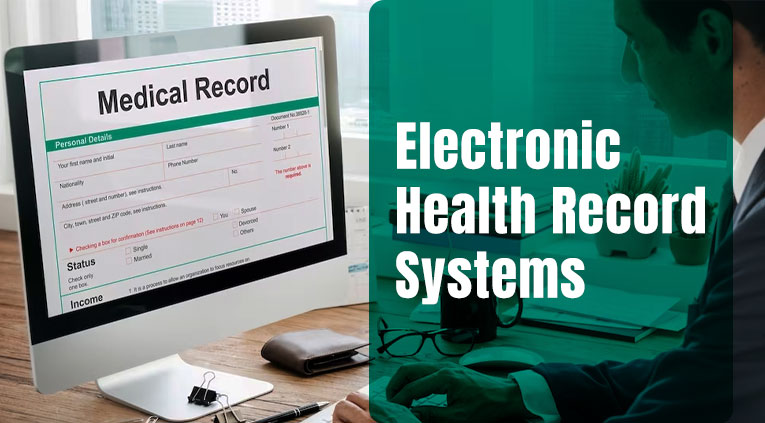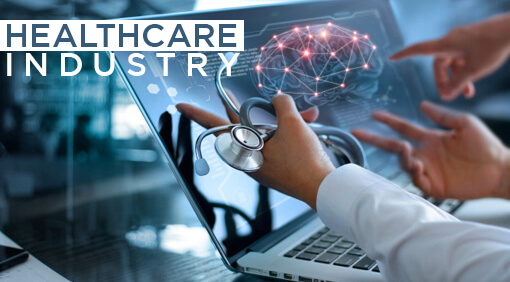The world of healthcare is rapidly evolving, and one of the most exciting developments in recent years has been the growing adaptation of a remote patient monitoring system. This technology provides a way for doctors to monitor their patient’s health without having to be physically present with them.
Remote patient monitoring (RPM) systems allow medical professionals to track vital signs such as heart rate, blood pressure, temperature, and other essential biomarkers from afar. This technology not only helps reduce costs by decreasing doctor visits but also allows for more efficient care delivery that can lead to improved outcomes and better quality of life for patients.
As such, it’s becoming increasingly popular among physicians and patients alike- making it an integral part of modern healthcare services. In this article, we will discuss the different types of RPM systems available, their components, as well as the steps involved in implementing them successfully. Before we dive into RPM details, let’s check out some statistics:
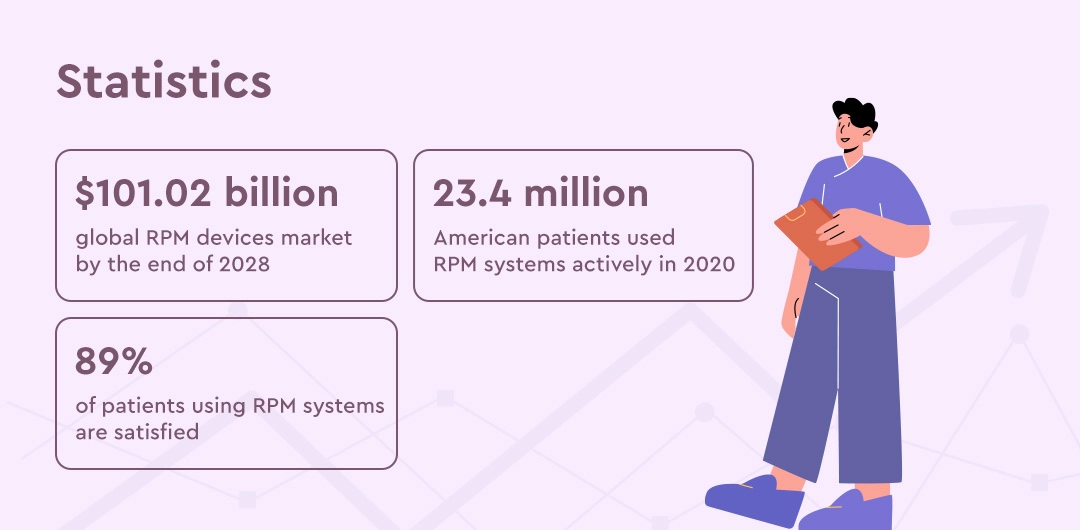
1. According to reports, the global RPM devices market is expected to surge from $30.05 billion in 2021 to around $101.02 billion by the end of 2028, with a CAGR of 18.9%.
2. Around 23.4 million American patients used RPM systems actively in 2020, and this number is constantly growing.
3. Around 89% of patients using RPM systems are satisfied with its applications, and there is a decrease of about 76% in hospital readmission rates after using these solutions.
These statistics prominently show the impact of RPM systems in modern healthcare. Now, let’s understand more about these systems and their applications.
What Exactly Is The Remote Patient Monitoring Software And Hardware Ecosystem?
Remote Patient Monitoring Systems are ways doctors can keep track of their patient’s health without being in the same place. Doctors can use a unique system to measure things like heart rate, blood pressure, and temperature from far away.
This system helps save money and time for both doctors and patients. It also keeps people healthier by keeping an eye on their health all the time. It is a set of technological advancements that help medical professionals to monitor their patient’s health remotely.
Sometimes, it becomes essential for doctors to have real-time patient data sitting at a remote location. RPM systems aid in this mission by providing doctors with reliable and accurate information to make timely decisions to ensure better outcomes for the patient.
RPM solutions can be software, hardware, or a robust combination. This technology focuses on chronic diseases, such as hypertension, diabetes, asthma, etc., and helps medical professionals to monitor a patient’s condition remotely. RPM also assists in providing long-term care to patients who cannot make it to their doctor’s clinic.
Benefits Of RPM Systems
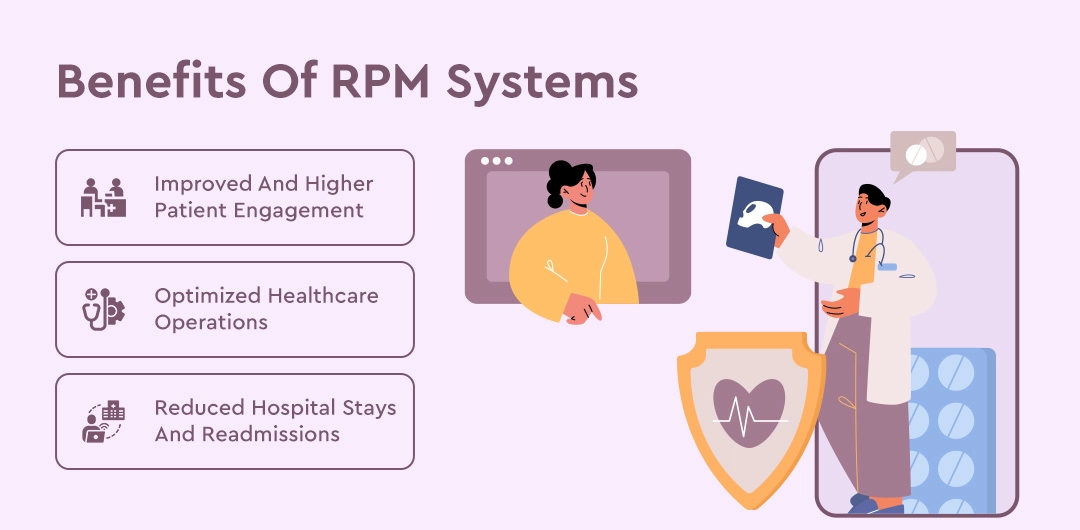
Lets understands the major benefits of RPM System.
Improved And Higher Patient Engagement
These systems provide an excellent way to help patients become more engaged in their healthcare. Patients can easily access data such as heart rate, etc., allowing them to feel more in control of their health.
Optimized Healthcare Operations
RPM systems also help healthcare providers improve their operational efficiency. It automates many labor-intensive processes, such as data collection and analysis, saving time and money.
Reduced Hospital Stays And Readmissions
These medical systems can help reduce hospital stays, as doctors can keep a close eye on the patient’s condition from afar. This can also lead to fewer readmissions, as any changes in a patient’s condition can be monitored and treated promptly.
On this note, let’s dive into the main types of remote patient monitoring systems and understand their components and implications.
Types of Remote Patient Monitoring Systems
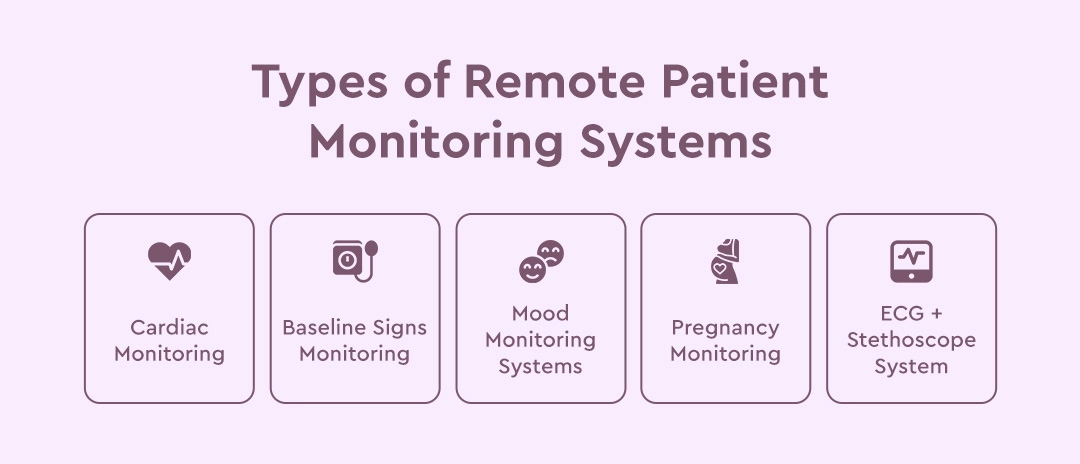
There are several custom RPM system solutions available in the market, and the system chosen depends on the unique requirements of each health clinic or hospital. However, below listed ones are the widely-used RPM systems that you need to know:
Cardiac Monitoring
This system includes sensors to monitor the patient’s heart rate, along with other cardiac biomarkers. Cardiac monitoring systems are commonly used for patients with hypertension and heart diseases. This system’s functioning helps detect cardiac issues and thus prevents more severe problems.
Compared to conventional monitoring systems, this technology is more economical and efficient. It’s because a single device attached to the patient’s body can provide all the necessary cardiac information. This system is ideal for individuals at a high risk of cardiovascular diseases and can not be monitored continuously in a hospital setting. Some of the key features of the cardiac monitoring RPM system are:
1. Real-time monitoring
2. Automatic recording of vital signs
3. A remote alarm system for emergency alerts
Baseline Signs Monitoring
This remote patient monitoring app system is used to monitor signs such as blood pressure, temperature, pulse oximetry, and respiratory rate. It is usually used for people with chronic diseases such as hypertension or diabetes. The baseline signs monitoring system helps medical professionals identify any changes in the patient’s vital signs and take necessary actions to prevent a medical emergency.
Patients with chronic respiratory diseases can also benefit from this system. It is designed to monitor various baseline signs such as oxygen saturation, breathing rate, pulse oximetry, and more. The system also helps identify any abnormalities in the patient’s respiratory patterns and provides medical attention if needed. Critical features of baseline signs monitoring solution are:
1. Monitoring of vital signs.
2. Automatic recording and analysis of data.
3. Data storage and sharing with healthcare providers.
Mood Monitoring Systems
Mood monitoring is an RPM system that helps monitor a patient’s emotional state and mental health. This system allows medical professionals to assess, monitor, and manage the patient’s mood and emotions remotely. It can be used to detect any changes in a person’s mental health or behavioral pattern and provide timely help.
Mood monitoring systems are ideal for patients suffering from mental health illnesses, such as depression and anxiety. The working of this system is simple; it collects data from the patient’s surroundings and analyzes it to identify any unusual behavior or changes in the patient’s mood. Some critical features of this RPM system are:
1. Analysis of the patient’s mood
2. Periodic recording, storage, and sharing of data
3. Automatic alerting in case of any abnormal changes
Pregnancy Monitoring
Pregnancy monitoring is a type of RPM system that helps medical professionals monitor the vital signs of a pregnant mother and her unborn child. This system includes various sensors that can track the patient’s health data, such as heart rate, oxygen saturation levels, temperature, and more.
It also helps to identify any complications in the baby’s development or any risk associated with pregnancy and provides medical attention if needed. This system is an excellent boon for pregnant women who need to travel frequently or stay away from the hospital for long hours. Some key features of this system are:
1. Comparing data to identify any abnormalities
2. Monitoring fetal heart rate and other vital signs
3. Alerts in case of any pain or discomfort
ECG + Stethoscope System
This type of RPM system combines a stethoscope and an electrocardiogram (ECG) to monitor cardiac activity in real-time. It is particularly beneficial for people suffering from cardiovascular diseases as it helps detect any abnormalities in their heart rhythm.
This system can also be used to identify any changes in the patient’s temperature, blood pressure, and other vital signs. Some key features of this system are:
1. Better insights into cardiac activity
2. Real-time monitoring of heart rate, ECG, and other vital signs
3. In case of any abnormalities, alert the medical professional
Now that we’ve explored some of the widely-used RPM systems let’s look at what makes up these systems and their main components.
Essential Components Of An RPM System
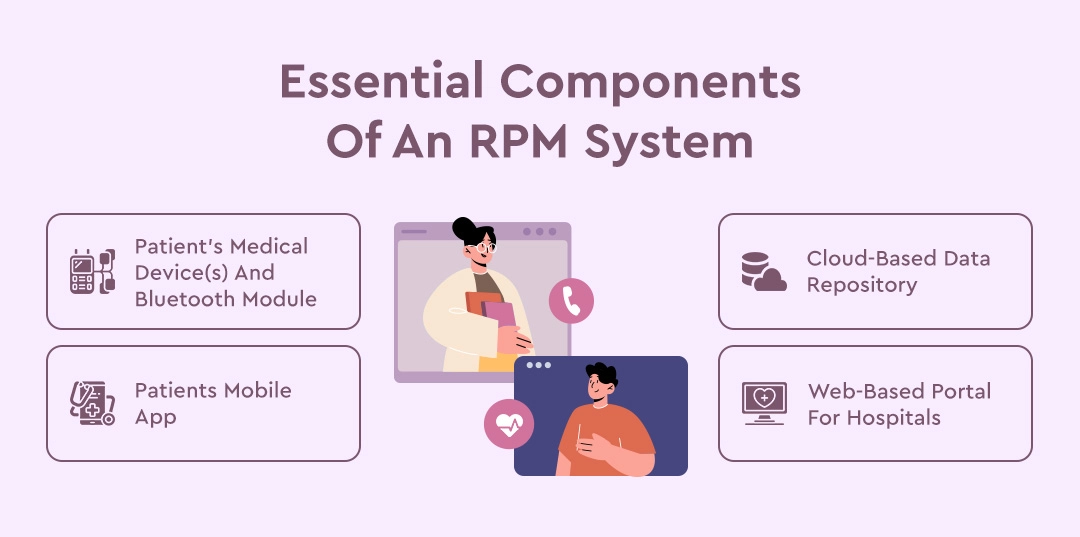
Patient’s Medical Device(s) And Bluetooth Module
This can be a smartphone, smartwatch, or another medical-grade device that collects data from the patient’s body and sends it to the remote monitoring device. The Bluetooth module helps to establish a connection between the patient’s medical device and the remote monitoring system.
Depending on the type of RPM system, the medical IoT devices can include a stethoscope, ECG monitor, pulse oximeter, thermometer, and more. The primary purpose of this device is to collect and transmit data from the patient’s body in real time.
All these devices should be able to comply with the relevant safety standards and have Bluetooth support for data transfer. Low-Bluetooth modules are also available, which help to reduce the data transfer latency.
Patients Mobile App
Most RPM systems have a dedicated mobile app for the patient. This app helps to track and monitor their health data, set reminders for medication and other tasks, contact their physician, and more. The user interface of this app should be easy to use and understand so that even non-tech-savvy patients can use it easily.
This app should also be secure and reliable to ensure that the patient’s data is not misused or leaked. The patient’s mobile app should comply with IEC 62304 standards, ensuring that it meets the safety and quality requirements of the medical device software.
This remote patient monitoring app will allow patients to check their health data and adjust settings or parameters as needed. On the other hand, medical professionals can use this app to monitor the patient’s data in real time and take necessary action if required.
Cloud-Based Data Repository
This component of the RPM system is used to store the patient’s health data in a secure and reliable manner. It should be able to collect, store, and analyze vast amounts of health data from multiple sources. This cloud-based storage will ensure that the patient’s data is not lost in case of any power outage or other unexpected issues.
This direct-to-cloud connectivity is recommended to comply with HIPAA guidelines and other privacy regulations. Additionally, it should be able to integrate with different systems, such as Electronic Health Record (EHR) systems and Clinical Decision Support (CDS) systems.
Cloud-based storage is an ideal approach to storing patient data as it can be accessed from anywhere, anytime. Moreover, doctors and other healthcare professionals can use this data for diagnosis and treatment.
Web-Based Portal For Hospitals
Now, hospitals will need a web-based portal to manage and monitor the patient’s health data. This portal should be able to integrate with multiple RPM systems so that it can collect and analyze data from different sources. It should also have reporting features so that the medical staff can track the patient’s progress easily.
This web-based portal should also allow the medical staff to access the necessary patient data quickly and efficiently. It should also have features such as electronic signature captures, document tracking, and automated alerts for any abnormalities in the patient’s vital signs, such as heart rate, ECG, and other vital signs.
In case of any abnormalities, it should be able to alert the medical professional immediately so that they can take the necessary action. Concerning the risk of unauthorized access, this portal should also have an authentication system to ensure that only authorized users are able to access the patient’s data.
Before you start your hunt for RPM developers for hire, you should be aware of the implementation process. This process should follow specific steps in order to ensure the successful deployment of the system. Let’s check out the RPM solution standard implementation steps.
Implementation Steps Of Remote Patient Monitoring Systems
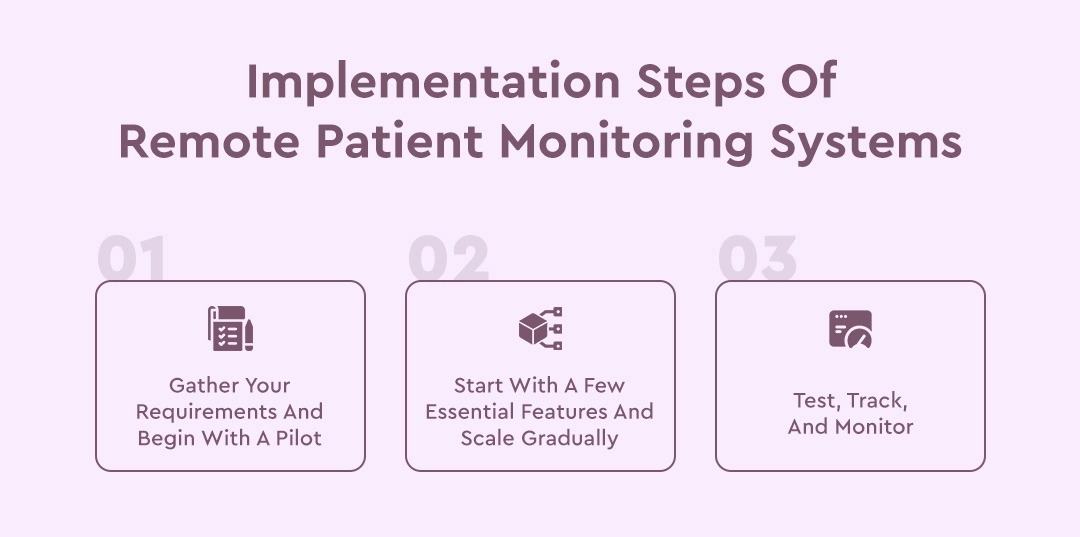
Gather Your Requirements And Begin With A Pilot
Before you start the development process, it is essential to understand your requirements and decide upon the features of your RPM system. You should determine what type of data you want to collect, how it should be collected and transmitted, and other related aspects.
It is also essential to decide upon the design of the RPM system. This can include the choice of hardware, software, networks, and other components that will be used in the system. After you have decided upon the design, you should create a pilot project to test the system and make sure it is working correctly before proceeding with the full implementation.
Start With A Few Essential Features And Scale Gradually
Once you have tested the system, you should start with the development process. It is important to start small and gradually scale up as needed. This will help you to identify any issues or bugs quickly and make sure that your system works efficiently.
You should also pay attention to user experience while developing the system and ensure that it is easy to use and understand by the users. This will make sure that the system is adopted quickly and used effectively. Think from the perspective of an end user and make sure that the system is intuitive and user-friendly.
Test, Track, And Monitor
Testing should be done at every stage of the development process to ensure that the system is working correctly. After you have developed the system, you should track user engagement to make sure that it is being used properly and efficiently.
You should also monitor any feedback from users so that you can identify any issues quickly and take corrective action if needed. This will help you to improve the system and make sure that it is functioning properly.
Finally, you should also regularly update the system to make sure that it is secure and safe from any malicious activity. Based on the country you’re in, you should also make sure that the system complies with the required local regulations.
This implementation process is incomplete without hiring a professional and experienced company like Auxano Global Services. With a healthcare IT development company, you can rest assured that your remote patient monitoring system will be developed and implemented quickly, securely, and efficiently.
Why Hire RPM Software Developer Teams From Auxano Global Services?
Auxano Global Services is a leading healthcare software development company with years of experience in developing and company with years of experience in developing remote patient monitoring systems. Our team is experienced in the development of complex healthcare IT solutions and can help you create a secure and efficient remote patient monitoring system.
We understand the importance of user experience and make sure that our systems are intuitive and easy to use. We also ensure that our systems are secure and compliant with local regulations. Our team is well-versed with the latest technologies and will help you develop a system that is reliable and cost-effective.

With our experienced team of healthcare IT experts, you can rest assured that your remote patient monitoring app will be developed quickly, securely, and efficiently. Contact AGS today to get started on the RPM project!
Wrapping Up!
Remote patient monitoring systems have revolutionized healthcare and enabled doctors to remotely monitor the health of their patients. With an RPM system, you can collect useful information about the patient’s condition and provide better care.
In 2024 when it comes to developing an RPM system, you should pay attention to the components, user experience, and security. Hire a professional healthcare software development company to develop an efficient and secure RPM system.
Frequently Asked Questions
-
1. How Much Does It Cost To Develop An RPM System?
The cost of developing an RPM system depends on several factors, such as the complexity of the system, the features you want to include, and the developers you hire. In addition, you should also consider the time and resources required to develop, test, and deploy the system.
-
2. What Are The Benefits Of Using An RPM System?
Remote patient monitoring systems offer several benefits, including improved diagnosis and treatment, cost savings, and better patient engagement. RPM systems are also easy to use and allow doctors to access data from anywhere.
-
3. Are RPM Systems Secure?
Yes, RPM systems are highly secure and compliant with local regulations. When developing an RPM system, you should make sure to use secure protocols and encryption methods to protect the patient’s data.
-
4. What Are The Components Of An RPM System?
The components of an RPM System include sensors, web or mobile apps, API integrations, and cloud storage. In addition, these components need to be integrated and connected to a secure network.
-
5. What Is The Best Way To Implement An RPM System?
The best way to implement an RPM system is to hire a professional healthcare software development company. With their experience and expertise, you can rest assured that your system will be developed quickly, securely, and efficiently.



